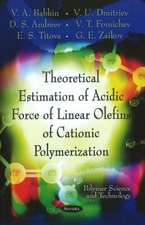Gradient HPLC of Copolymers and Chromatographic Cross-Fractionation
Autor Gottfried Glöckneren Limba Engleză Paperback – 23 feb 2012
Preț: 384.48 lei
Nou
Puncte Express: 577
Preț estimativ în valută:
73.57€ • 77.02$ • 60.87£
73.57€ • 77.02$ • 60.87£
Carte tipărită la comandă
Livrare economică 05-19 aprilie
Preluare comenzi: 021 569.72.76
Specificații
ISBN-13: 9783642758010
ISBN-10: 3642758010
Pagini: 232
Ilustrații: XVI, 210 p.
Dimensiuni: 155 x 235 x 12 mm
Greutate: 0.33 kg
Ediția:Softcover reprint of the original 1st ed. 1991
Editura: Springer Berlin, Heidelberg
Colecția Springer
Locul publicării:Berlin, Heidelberg, Germany
ISBN-10: 3642758010
Pagini: 232
Ilustrații: XVI, 210 p.
Dimensiuni: 155 x 235 x 12 mm
Greutate: 0.33 kg
Ediția:Softcover reprint of the original 1st ed. 1991
Editura: Springer Berlin, Heidelberg
Colecția Springer
Locul publicării:Berlin, Heidelberg, Germany
Public țintă
Professional/practitionerCuprins
1 Introduction.- 1.1 About the Aims and Methods of Cross Fractionation.- 1.2 Classical Cross-Fractionation.- 1.3 Cross Fractionation Including Size Exclusion Chromatography.- 1.3.1 SEC Analysis of Fractions Obtained by Precipitation or Extraction.- 1.3.2 Preparative Thin-Layer Chromatography and SEC Analysis of the Fractions.- 1.3.3 Preparative SEC and TLC Analysis of the Fractions.- 1.4 Cross Fractionation by Coupled SEC Techniques.- 1.5 Elution Under Critical Conditions.- 1.6 References.- 2 Chemical Heterogeneity of Copolymers.- 2.1 Sequence Distribution.- 2.2 Instantaneous Heterogeneity.- 2.3 Modification of the Stockmayer Distribution.- 2.4 Conversion Heterogeneity.- 2.5 References.- 3 Size Exclusion Liquid Chromatography of Copolymers.- 3.1 Universal Calibration.- 3.2 Secondary Exclusion and Adsorption Effects.- 3.3 Detector Response.- 3.4 Fractionation by Hydrodynamic Volume.- 3.5 References.- 4 Special Features of Polymer HPLC.- 4.1 Diffusion Coefficients of Macromolecules in Solution.- 4.2 Stokes Radii and Hydrodynamic Dimensions of Macromolecules.- 4.3 Retention by Multiple Attachment.- 4.4 Conformation of Synthetic Polymers.- 4.5 Solubility of Polymers.- 4.6 Gradient Elution of Polymers.- 4.7 Gradient Elution of Polymers on Small Pore Packings.- 4.8 The Martin Equation.- 4.9 Effect of Block Structure on Retention.- 4.10 References.- 5 Solubility and Adsorption Effects in Polymer HPLC.- 5.1 Dependence of Retention Time on Sample Size.- 5.2 Comparison Between Solubility and Elution Characteristics...- 5.3 Correspondence Between Column Polarity and Gradient Orientation.- 5.4 Effect of Temperature.- 5.5 High-Performance Precipitation Liquid Chromatography.- 5.6 Normal-Phase Gradient Elution with Separate Adjustment of Polarity and Solvent Strength.- 5.7 References.- 6 Effect of Mobile and Stationary Phase in Polymer HPLC.- 6.1 Elution in the Critical Region.- 6.2 The Role of the Stationary Phase.- 6.3 Normal and Reversed Phase HPLC of Polymers.- 6.4 References.- 7 Detection in Gradient High-Performance Liquid Chromatography.- 7.1 Selective Detectors.- 7.2 Detection Subsequent to Eluent Vaporization.- 7.3 References.- 8 Quantitative Evaluation and Calibration.- 8.1 Features of a Proper Run in Polymer HPLC.- 8.2 Quantitative Evaluation.- 8.3 Incomplete Retention and Elution.- 8.4 Signal Enhancement by Turbidity.- 8.5 Calibration of Polymer Gradient HPLC.- 8.6 References.- 9 Separation of Copolymers by Composition through Gradient High-Performance Liquid Chromatography.- 9.1 Statistical Copolymers from Styrene and Acrylonitrile.- 9.2 Statistical Copolymers from Styrene and Methyl Acrylate.- 9.3 Copolymers from Styrene and Methyl Methacrylate.- 9.4 Statistical Copolymers from Styrene and Ethyl Acrylate.- 9.5 Statistical Copolymers from Styrene and Ethyl Methacrylate..- 9.6 Copolymers from Styrene and t-Butyl Methacrylate.- 9.7 Alkyl Methacrylates and Acrylates with Different Side Groups.- 9.8 Copolymers from Methyl Methacrylate and Methyl Acrylate..- 9.9 Copolymers from Styrene and 2-Methoxyethyl Methacrylate...- 9.10 Copolymers of Styrene and Butadiene.- 9.11 Copolymers of Decyl Methacrylate and Methyl Methacrylate..- 9.12 Graft Copolymers of Methyl Methacrylate onto Copoly (Ethylene/Propylene/Diene Monomer) (EPDM).- 9.13 Epoxy Composite Formulations, Phenol-Formaldehyde Prepolymers, Macromonomers, and Telechelic Prepolymers.- 9.14 Ethylene/?-Olefm Copolymers.- 9.15 Copolymers of Styrene and Acrylic Acid.- 9.16 Separation of PMMA Isomers.- 9.17 References.- 10 Chromatographic Cross-Fractionation.- 10.1 Scope of this Chapter.- 10.2Comparison of Calculated and Measured Curves of Chemical Composition Distribution.- 10.3 Chromatographic Cross-Fractionation of Model Mixtures 151 10.3.1 Model Mixtures of stat-Copoly(Styrene/Acrylonitrile).- 10.4 Chromatographic Cross-Fractionation of Real Copolymers...- 10.5 Cross Fractionation by Temperature-Rising Elution Fractionation and SEC Analysis of the Fractions.- 10.6 Chromatographic Cross-Fractionation of Graft Copolymers of Methyl Methacrylate onto Copoly(Ethylene/Propylene/Diene Monomer) (EPDM Rubber).- 10.7 Chromatographic Cross-Fractionation of Styrene/Vinyl Acetate Block Copolymers.- 10.8 References.- 11 Experimental Problems.- 11.1 THF as a Mobile Phase.- 11.2 Sample Solvent.- 11.3 Ghost Peaks.- 11.4 Sample Load and Column Blocking.- 11.5 Hazards Caused by Incompatible Sample Polymers.- 11.6 Column Flushing.- 11.7 Effect of Column Length.- 11.8 Peak Splitting.- 11.9 Column Conditioning by Sample Injection.- 11.10 Guidelines for Selecting Suitable Phase Systems for Copolymer HPLC.- 11.11 References.- 12 Glossary of Terms.- Author Index.










